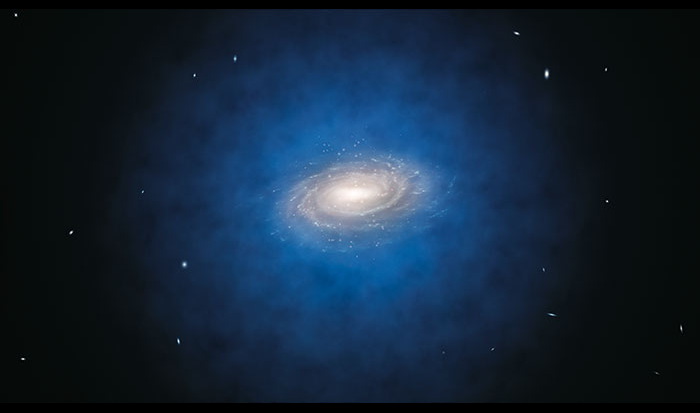Milky Way Weighs in Light, Using a Well-Worn Technique

A new measurement of the mass of the Milky Way galaxy suggests that Earth's galactic home is a bit lighter than many previous estimates suggested, but the scientists behind the new work say it's the method that matters.
The Milky Way galaxy is made up of stars, planets, clouds of gas, and a zoo of other objects and features. It's also surrounded by a halo of dark matter, the mysterious substance that is five times more common in the universe than "regular" matter but that does not interact with light. Dark matter is, as a result, extremely difficult for astronomers to study.
The new mass measurement finds that the Milky Way is between 400 billion and 780 billion times the mass of the sun. This measurement gives scientists an idea of how much dark matter the Milky Way's halo contains, and that knowledge can propagate out into the many aspects of astronomy that intersect with the study of dark matter, according to the authors of the new work. [Stunning Photos of Our Milky Way Galaxy (Gallery)]
A dark mystery
Dark matter doesn't radiate, reflect or absorb light; it is virtually invisible to astronomers, revealing itself only through gravity. Clumps of dark matter are able to bend starlight the way a black hole does, in a phenomenon called gravitational lensing. In addition, the observed movement of stars and other material inside large galaxies can't be explained by the presence of regular matter alone; there must be a significant amount of invisible matter exerting a gravitational force on those galaxies as well.
"There's all sorts of different facets of research in astronomy where dark matter is important," Gwendolyn Eadie, a Ph.D. candidate in astrophysics at McMasters University in Ontario, Canada, and co-author on the new research, told Space.com.
But major questions still remain about this mysterious substance.
"Even though we know the dark matter should be there, [and] we think it should be there, the ratio of dark matter to luminous matter in particular galaxies may be under debate," Eadie said.
Breaking space news, the latest updates on rocket launches, skywatching events and more!
Measurements of the Milky Way's mass include the mass of the dark matter halo. Adding an improved mass of the Milky Way to computer simulations of the galaxy (and others like it) "ultimately tests our understanding of how the universe has evolved and how galaxies form in the presence of dark matter," Eadie told Space.com. That means that understanding the local dark matter environment can help scientists better understand the role that dark matter plays in the larger cosmic landscape.
To make the new measurement of the Milky Way mass, scientists looked at how other massive things move around the galaxy. This is a typical approach, and in this case, the researchers focused on objects called globular clusters, or dense groups of stars that aren't large enough to be galaxies. A total of 157 known globular clusters in the Milky Way, and the galaxy's mass influences the motion of each of the clusters, almost as if they were balls on a string. If the string were invisible, the motion of the ball would still reveal the influence of the string.
But a method that utilizes the motion of globular clusters requires data showing how those clusters move, and that data isn't uniform across the board, Eadie explained in the news conference. Some of those clusters are very far away or positioned such that it is difficult to measure their motion in every direction. Even if it's possible to see how quickly these galaxies are moving toward or away from Earth, measuring their movement across the sky can be difficult, because they appear to move very slowly (at least compared to human lifetimes), Eadie said.
The problem gets even more complicated because scientists have to figure out the motion of the globular clusters relative to the center of the galaxy, but the sun is located very far away from that center, Eadie said. So, all the measurements of the globular cluster motions have to be "translated" to the center of the galaxy, and it's difficult to do that when those measurements are incomplete (for example, when there is no measurement of a globular cluster's movement across the sky). For that reason, many techniques for measuring the mass of the Milky Way cannot use all the data that is available, Eadie said at the news conference.
The new technique, however, uses almost all of the available data on globular cluster measurements, Eadie said. She and her colleagues accomplished that feat by using an established statistics technique called a hierarchical Bayesian model. The details get pretty hairy, but essentially the technique is better at incorporating incomplete or highly uncertain measurements, Eadie said. The final result also takes into account the uncertainty in those measurements, so if a measurement is very unreliable, will have less impact on the final result, Eadie said.
One previous attempt to measure the mass of the Milky Way via globular clusters used data on only 89 out of 157 globular clusters, and did not incorporate those measurement uncertainties. It came up with a result of around 680 billion solar masses, which falls within the range of the new measurement, "which is encouraging," Eadie said. [Gallery: Dark Matter Throughout the Universe]
"These results are [also] encouraging, and the method in particular is encouraging," she said. "Being able to incorporate these measurement uncertainties in a meaningful way is something that could have broad implications for other areas of astronomy as well, where measurements are always uncertain, and we often have incomplete measurements."
The new technique may also help solve another key problem astronomers face in measuring the galaxy's mass: It's not always clear where the galaxy stops and the rest of space begins. Deciding on the radius of the Milky Way is sort of like trying to find the "edge" of a very wispy cloud. Different measurements of the galaxy's mass are calculated out to different distances from the galactic center, making it difficult to compare the results, according to Eadie.
The new results provide a "mass profile" that gives a range of what the mass should be at different distances from the galactic center. The profile shows that the mass of the galaxy is between 400 billion and 580 billion times the mass of the sun out to a radius of 125 kiloparsecs (roughly 407,695 light years, or 3.8 x 1018 kilometers). If that radius is extended to something called the "virial radius," which is 179 kiloparsecs (583,820 light years or 5.52 x 1018 kilometers) then the mass estimate is between 470 billion to 780 billion times the mass of the sun. The mass profile also includes the uncertainty in those measurements, making it clear if a previous measurement overlaps with the new one, Eadie said.
Improvements to come
The new measurement isn't the end of the story, Eadie told Space.com. The numbers will likely change as scientists get better measurements of the motions of the globular clusters, she said. A project underway called the Hubble Space Telescope Proper Motion Collaboration (HSTPROMO) is working on getting new measurements or improved measurements for the motions of nearby globular clusters.
In addition, the hierarchical Bayesian technique relies on physical models of the galaxy and the distribution of globular clusters in the galaxy, but aspects of those models could be improved, Eadie said. For example, the model of the galaxy used in the new mass calculation assumes the dark matter halo is not rotating along with the "regular" matter, but that assumption "may or may not be true," Eadie told Space.com. So, improvements to the models could also help refine the mass measurements, she said.
Eadie added that she is looking forward to getting new data from the European Space Agency's Gaia spacecraft, which will provide measurements of the motion of billions of stars in the Milky Way; that data could also be used to make a mass measurement of the galaxy, which could then be compared with the new measurement by Eadie and her colleagues.
The hierarchical Bayesian analysis is a well-established statistical technique that's used in ecology, biostatistics and cosmology, Eadie said. She said she thinks it could be a great help to astronomers in the age of "big data," when instruments like the Large Synoptic Survey Telescope will be producing terabytes of data every few days.
"I think it's great that now [hierarchical Bayesian analysis] is starting to gain traction in astronomy," she said. "As a community, we're starting to realize it's a powerful method to be using."
Follow Calla Cofield @callacofield. Follow us @Spacedotcom, Facebook and Google+. Original article on Space.com.

Calla Cofield joined Space.com's crew in October 2014. She enjoys writing about black holes, exploding stars, ripples in space-time, science in comic books, and all the mysteries of the cosmos. Prior to joining Space.com Calla worked as a freelance writer, with her work appearing in APS News, Symmetry magazine, Scientific American, Nature News, Physics World, and others. From 2010 to 2014 she was a producer for The Physics Central Podcast. Previously, Calla worked at the American Museum of Natural History in New York City (hands down the best office building ever) and SLAC National Accelerator Laboratory in California. Calla studied physics at the University of Massachusetts, Amherst and is originally from Sandy, Utah. In 2018, Calla left Space.com to join NASA's Jet Propulsion Laboratory media team where she oversees astronomy, physics, exoplanets and the Cold Atom Lab mission. She has been underground at three of the largest particle accelerators in the world and would really like to know what the heck dark matter is. Contact Calla via: E-Mail – Twitter

